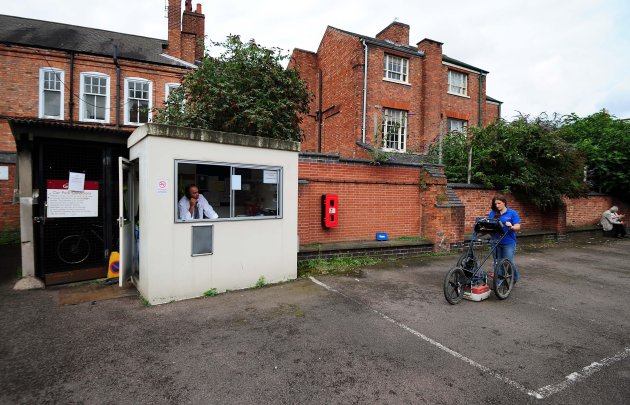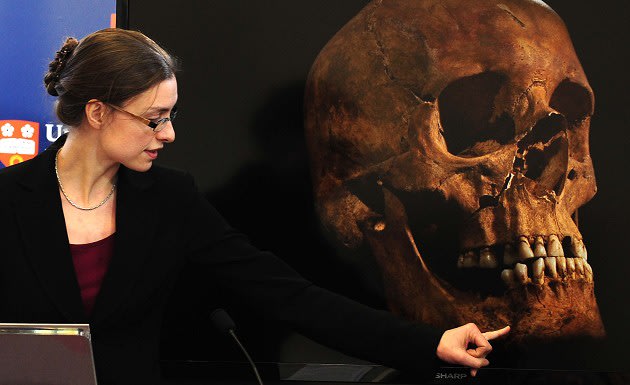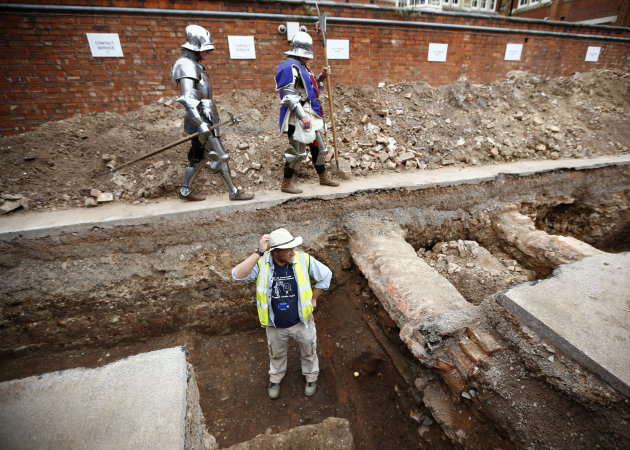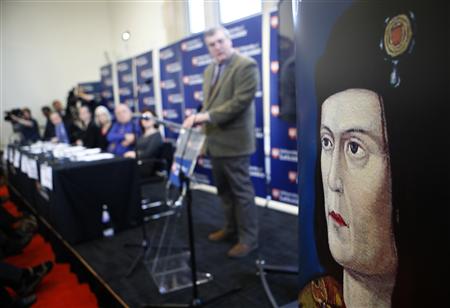Shakespeare and literary critics describe him as a horrible king, but other researchers have said that he was a
good king with nice personal qualities and characters. Whom should we believe? That his 500 year body was found under a parking lot is just revealing, no less fantastic
Car park skull 'was that of King Richard III' say experts
Researchers said there is a 'highly conclusive case' that the battle-damaged remains found in a Leicester car park belonged to the 15th-century monarch.
Scientists today revealed that a skeleton discovered under a car park in Leicester is that of King Richard III.
Researchers sensationally discovered a skull under the social services car park in September while hunting for the former king's final resting place.
They had previously said there was 'strong circumstantial evidence' to suggest the bones are those of the 15th-century monarch, but experts were finally able to disclose the results of much-anticipated tests on the remains today.
The skeleton had a metal arrowhead lodged in its spine, along with other injuries matching those which Richard III sustained when he was killed at the Battle of Bosworth in 1485.
The remains also had signs of 'battle trauma' and scoliosis - the spinal condition which gave the medieval monarch his infamous hunched back.
Richard III was the last English monarch to die in battle, after being defeated by an army led by Henry Tudor.
Historical records state that his body was taken 15 miles to Leicester, where it was displayed as proof of his death before then being buried in the Franciscan friary.
Experts today said that in making the 'momentous' find, they had 'unlocked a 500-year-old mystery'.
They revealed their findings this morning in front of almost 150 journalists from around the world.
Initial examinations showed the bones to be those of an adult male and the remains were said to be in a good condition.
Researchers sensationally discovered a skull under the social services car park in September while hunting for the former king's final resting place.
They had previously said there was 'strong circumstantial evidence' to suggest the bones are those of the 15th-century monarch, but experts were finally able to disclose the results of much-anticipated tests on the remains today.
The skeleton had a metal arrowhead lodged in its spine, along with other injuries matching those which Richard III sustained when he was killed at the Battle of Bosworth in 1485.
The remains also had signs of 'battle trauma' and scoliosis - the spinal condition which gave the medieval monarch his infamous hunched back.
Richard III was the last English monarch to die in battle, after being defeated by an army led by Henry Tudor.
Historical records state that his body was taken 15 miles to Leicester, where it was displayed as proof of his death before then being buried in the Franciscan friary.
Experts today said that in making the 'momentous' find, they had 'unlocked a 500-year-old mystery'.
They revealed their findings this morning in front of almost 150 journalists from around the world.
Initial examinations showed the bones to be those of an adult male and the remains were said to be in a good condition.
A team led by bioarchaeology lecturer Dr Jo Appleby carried out months of skeletal analysis on the bones - including CT scans.
There were cheers from media who had gathered from around the world as the announcement was made at the University of Leicester this morning.
Dr Jo Appleby said the skeleton was found in good condition with its feet missing in a grave.
Its hand were crossed over the front of the pelvis and there was no evidence of a coffin or shroud found with the skeleton.
Dr Appleby said: "The skull was in good condition, although fragile, and was able to give us detailed information about this individual.
"It has been CT scanned at high resolution in order to allow us to investigate interesting features in as much detail as possible.
"In order to determine whether this individual is Richard III we have built up a biological profile of its characteristics.
 Find: The car park in Leicester where excavations took place (PA)
Find: The car park in Leicester where excavations took place (PA)"We have also carefully examined the skeleton for traces of a violent death."
DNA taken from the skeleton has been analysed and compared with that of Michael Ibsen, a descendant of Richard III's family.
Radiocarbon tests and genealogical studies have also taken place.
Richard III's demise was dramatised by Shakespeare, who had the king calling out "a horse, a horse, my kingdom for a horse" before he was killed on the battlefield.
The remains were also subjected to DNA tests and compared against the genetic profile of one of Richard III's living relatives.
Furniture maker Michael Ibsen, from London, is a direct descendent of the king's sister, Anne of York and provided a sample to be used in testing.
The dig which unearthed the remains centred around a car park in Leicester City Centre which was used by social workers.
Historical documents said that it was the site of the Grey Friars church, and that Richard's body was taken there following his death.
@YahooNewsUK on Twitter, become a fan on Facebook








No comments:
Post a Comment